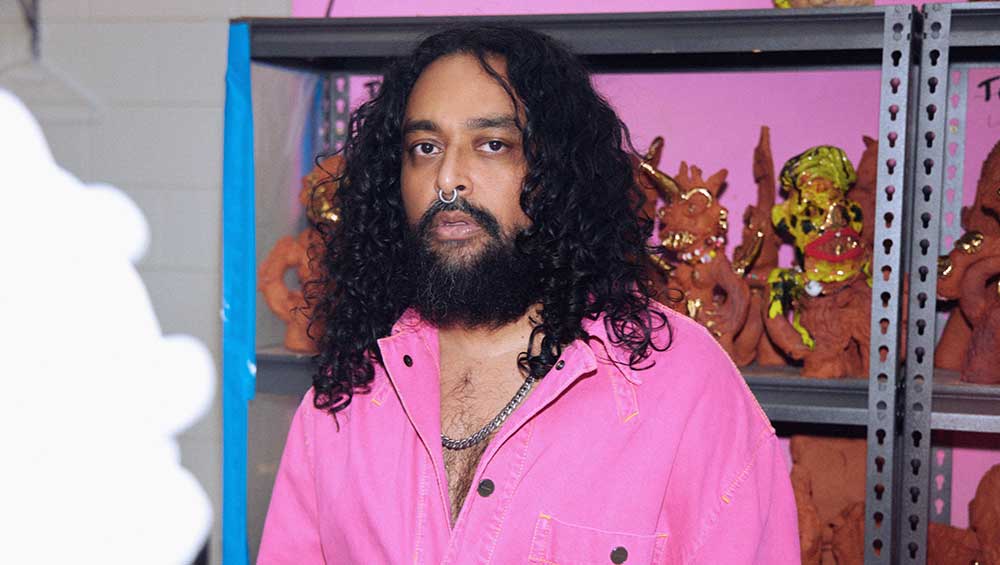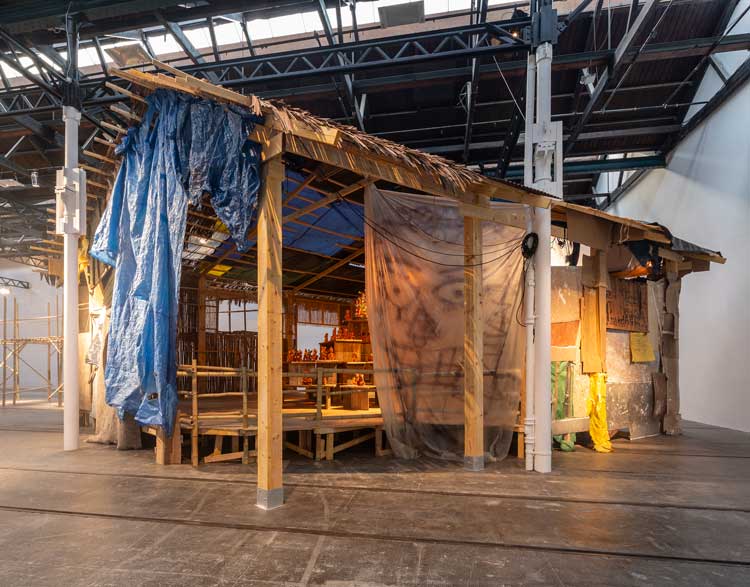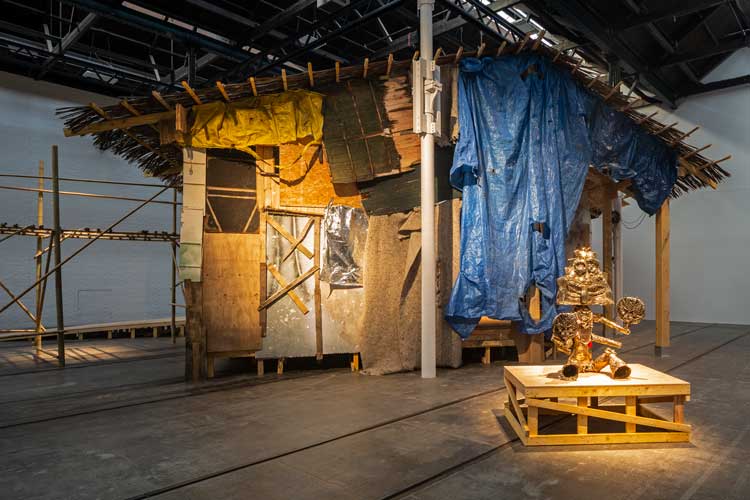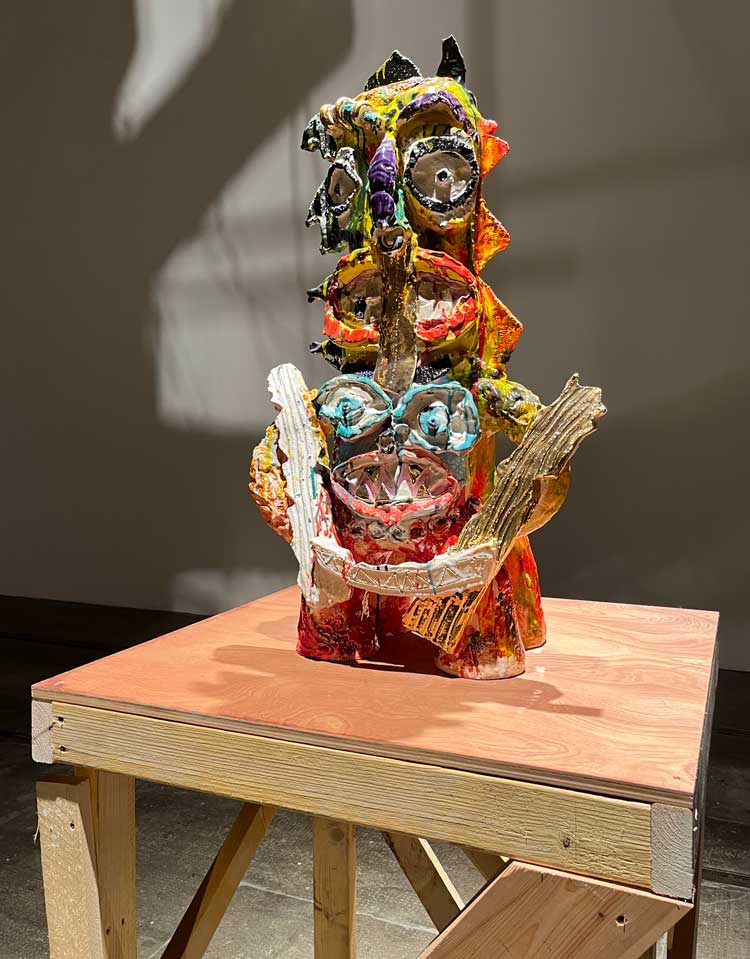
Ramesh Mario Nithiyendran. Photo: Bowen Aricò.
by VERONICA SIMPSON
Idols of Mud and Water at the Tramway, Glasgow, places the exuberant work of Ramesh Mario Nithiyendran in a whole new light. Along with a mass of the colourful ceramic and bronze figurines evoking totems, ancient deities and ritualistic practices for which he is known, for his first UK and European show, he has also produced the biggest work he has ever made – a 10 metre-tall idol moulded from Glasgow mud.
This idol looms towards the gallery visitor, half obscured by the bright spotlights on the totems around it, as well as clouds of haze that drift across the room intermittently. In a playful riff on classical statuary and display, the figure is reflected in a ramshackle pool at its base, framed by sandbags, into which various spouts dribble thin spurts of water. Contrasting with this primitive, slightly menacing scene are the brightly coloured neon cables, which drip and droop from its frame – a hint of the urban, as is the teetering structure of scaffolding that props up this idol, and also weaves across the room, linking us to another ramshackle structure: a shelter-cum-temple made from salvaged wood, scaffolding and bamboo poles (also Glasgow sourced). In here, about 100 terracotta sculptures are piled on to a charmingly DIY-tiered plinth, with blobs of gilding applied seemingly haphazardly to their earthy, unglazed features.
.jpg)
Ramesh Mario Nithiyendran. Multi Limbed Mud Fountain, 2023. Mud cob, straw, paint, LED rope, electrical cable. Photo courtesy Tramway.
With these and the assorted characters spotlit around the room, the artist has successfully synthesised the weird and primal attractions of his figures into a stage set that looks at once familiar and utterly alien - equal parts Apocalypse Now, Raiders of the Lost Ark, Godzilla and Nithiyendran’s own imaginative cartoon-esque (and also game design-infused) universe. He calls it “a buzzing mythological playground in which queer politics, anthropomorphism, monumentality and popular culture combine”. He challenges us to think about the role of rituals in our lives personally and universally.
Born in Colombo, Sri-Lanka in 1988, Nithiyendran has lived in Australia since 1989. From the University of New South Wales, he received his BA/BFA in 2011 and an MFA in 2013. He has had solo and group shows including at: Kiran Nadar Museum of Art, Delhi (2023); Sharjah Art Foundation, Sharjah (2022); Art Gallery of New South Wales, Sydney (2022); The Museum of Applied Arts and Sciences, New South Wales (2021); Melbourne Art Foundation, Melbourne (2020); The National Gallery of Australia, Canberra (2016); Dhaka Art Summit (2016); Adelaide Biennial of Australian Art (2016); Kuandu Biennale, Taipei (2016); and Shepparton Art Museum, Victoria (2015).
After visiting the show, Studio International spoke to the artist by Zoom.
Veronica Simpson: Rethinking idols and imagery is such an interesting move, given the virtualisation of our lives and friendships that has created multiple alternative versions of ourselves - as well as making idols of those who have greatest traction on this technology. When did you start working with deities of all kinds?
Ramesh Mario Nithiyendran: I think I’ve always been drawn to things that have a sense of hyperbole, imagination or speculation in their aesthetic. Even to this day when I’m looking at films, it’s animations that I find the most interesting to watch. We’re able to imagine reality in ways that are different.
When I was growing up, I had a very secular or atheist belief system, but I was always drawn to the imaginative potential within the religion that my father’s side practised, which was Hinduism. I liked the imaginative potential that things were rising and going above to higher planes, and the Hindu suite of imagery was quite literally imaginative in that things were zoomorphic. Stories were often polymorphous and had this plurality to them. Things shape-shifted, things changed, and I think that was probably what appealed to my imaginative potential.

Installation view, Ramesh Mario Nithiyendran: Idols of Mud and Water, Tramway, Glasgow, 2023. Photo courtesy Tramway.
But now what I’m interested in is types of languages, visual languages that are syncretic - things that emerge through different cultures or religions or schools of thought in lots of ways. Most types of visual representation are syncretic. But from an academic perspective, something that really inspired me as well, is that a lot of the ancient idols or iconographies have endured over thousands of years. And I think there’s something to say about that. Contemporary art often goes through these very specific zeitgeist trends. That’s fashionable one day isn’t the next. And yet there’s always been this enduring capacity to a lot of this religious iconography and sculpture, particularly from Asia. I think there’s an element of wonder and specialness.
The way I was trained at university was that contemporary art was all about materials, but it was being dematerialised: it was the ideas that made the work special or captivating. I’ve always been interested in more intuitive, non-linear ways to look at culture. And I think looking at a lot of sculpture from Asia, especially ancient sculpture, really taps into multiple parts of me – intellectual, emotional, sentimental.
VS: In the short video introducing the installation, on the Tramway website, you talk about being particularly drawn to south Asian mythologies, and the fact that there would be body parts missing, and the weirdness of that.
RMN: It’s interesting when you think about the cultural lens we impose on that kind of imagery. I think that’s why I’ve always been drawn to gatekeeper guardians as an archetype: because they’re about protection. Historically they had an important role, to protect these places of worship, to highlight that these are places of importance.

Installation view, Ramesh Mario Nithiyendran: Idols of Mud and Water, Tramway, Glasgow, 2023. Photo courtesy Tramway.
VS: For representing ancient and modern culture, Tramway is a particularly interesting site - sandwiched between a Gurdwara Temple and a giant Lidl supermarket.
RMN: The main thing that appealed to me about Tramway initially was the architecture. It’s not a museum site, it’s not a white cube, it’s a site that naturally maximises explorations of scale. So, it’s not a place for plinths or vitrines. I think emerging from this multi-art context, which is also about theatre and sound and lighting, is where I started to think about it. Glasgow was interesting to me because of the fabrication possibilities that we could engage with. The kind of practice I have is a very material practice. I can talk a lot, but at the end of the day I’m moving materials around, I’m collapsing things together, I’m putting things under 1000s of degrees of heat. It was a post-industrial, non-museum, multi-art space, but with this interesting positioning within the UK and very multicultural, which allowed the ideas to emerge quite fluidly.
VS: The giant mud-formed figure and ramshackle structures reminded me of Raiders of the Lost Ark, amid a jumble of other references, ancient and modern. The whole installation hits that sweet spot of being alien yet familiar.
RMN: Oh, that’s good. I think part of creating the work, especially at scale, is to explore those lines between ambiguity and familiarity. A foreignness and that sense of unease in locating even the narrative function of the figures allows more engagement. I think as an artist I’ve never created very linear narratives, though with the terracotta sculptures there’s a narrative of evolution among them. About 30 of them are formless and lumpy and the last 30 are highly detailed and highly ornate and have multiple heads. I didn’t want to present them in any lineage. I think that uncertainty is good for an audience, to be honest.
-and-Head-with-Many-Protrusions-II-(2023).jpg)
Ramesh Mario Nithiyendran. Terracotta Figures (1-97) and Head with Many Protrusions II, 2023. Terrecota, glazed ceramic, beads, dimensions variable. Photo courtesy Tramway.
VS: Definitely. After all, that’s what triggers curiosity and, hopefully, a sense of wonder. It’s an extraordinary and complex and ambitious feat, conjuring all these figurines from clay and mud. Presumably you had help making the mud sculpture.
RMN: Yes, the large, ephemeral fountain sculpture was made in Glasgow. It was fabricated there with an earth building team local to the area. All the fired ceramics and bronze sculptures in the show were made in Sydney and Melbourne. The house or shelter sculpture was made with all kinds of recycled materials. Even the bamboo was sourced in the UK. There’s this interesting global narrative that comes through working in that way. When I was creating that work, I thought it would be really interesting to show the labour: you could tell there was a team. But with the terracottas [figurines in the “temple”] I wanted there to be that intimate, repetitive quality: you were imagining what the artist was doing in different moods and tones.
.-Pic-V-Simpson.jpg)
Terracotta Figures (detail), installation view, Ramesh Mario Nithiyendran: Idols of Mud and Water, Tramway, Glasgow, 2023. Photo: Veronica Simpson.
VS: I liked the somewhat haphazard application of gold on these small figures.
RMN: There’s gold lustre on them – it’s a technique that has been in ceramics for a long time. A lot of Wedgwood porcelain used that gold lustre to create an attractive, glossy finish. For me, there was something appealing about gilding a raw material, gilding the earth - high gloss v matt. I’m trying to complicate the readings a little bit.
VS: There are many fabulous colours on the spotlit figures placed around the room. I understand it is extremely difficult to achieve that kind of rainbow spectrum on glazed vessels.
RMN: With this installation, the colours are intentional. There are three or four colourful works, but everything else has this earthy, industrial, almost apocalyptic sentiment. Working with glazed ceramics and bright colours is an alchemical process. A difference of 100 degrees can make a really bright colour go super dull. I think what it is, it’s a load of building up experience with those materials over time and being able to trial and test them, but at the same time leaving room for things to be spontaneous.
There’s this sense, when you’re able to open the kiln after a few days, if you’re not sure what it’s going to look like, you’re really excited. If you knew how they were going to turn out, I think that sense of joy would diminish.
-2023.jpg)
Ramesh Mario Nithiyendran. Multiheaded Figure in Drapery (King), 2023. Glazed ceramic beads, fabric, 159 x 63 x 63 cm. Photo courtesy Tramway.
VS: It’s a real technical achievement, but the colours do give a joyful quality to those figures. There’s weirdness but there’s also glee.
RMN: I still get taken aback that people aren’t interested in the technical aspects of ceramics. It seems that that’s not cerebral enough. Very seldom do people show interest in the technical, trial and error approach. A lot of the time I’m talking about the ideas and the context, whereas the reality of the studio is interpreting moisture etc.
I started making ceramics in 2012 when I was still at university, doing my master’s. I never had training. But a lot of people projected this idea that I was breaking rules and challenging traditions. Yet the history of ceramic, figurative sculpture is as ancient as any. Sometimes I look at the terracotta structures in collections that are thousands of years old, and they make my structures look conservative - some of these things are so wild and technically ambitious and complex. So, I’ve never thought of myself as rewriting rules: it’s just been a narrative that’s been layered on me at a time when we were still grappling with what the medium would be.
VS: Luckily, clay’s moment in contemporary art has truly arrived. When did you start casting some of your figures in bronze, and why?
RMN: I first started working with bronze in 2016 and, again, I was thinking about south Asian bronzes. Also, especially in Australia, placemaking colonial sculptures are often bronze. I was always thinking about the elements – earth, water, fire, metal. For Glasgow, I was thinking about electricity and smoke. And I think working with bronze is really interesting because the casting process, the principles of it, are so ancient – for example lost wax casting. To me, working with ceramics and bronze, you can create these really interesting dialogues with these sculptures. That’s what started the process for me. And when I started making bronzes, they were like a big financial investment. I don’t have a trust fund. I’m from a working-class Sri Lankan refugee family. So, I thought to myself I want to explore this medium, I’m going to save up and make some bronzes, because that’s something I felt passionate about and I liked the collaboration involved - working with foundries. But now it’s just part of my work.

Ramesh Mario Nithiyendran. Guardian Figure with Shields, 2023. Glazed ceramic, 85 x 65 x 45 cm. Photo: Veronica Simpson.
VS: In the Tramway website film, in your studio you showed a mix and match approach to which head you’re going to give which body. Presumably you have various scales you work to so you can play with these components.
RMN: With ceramics there’s so much guessing. Once you put on a layer of colour, even the emotional reading can change when it comes out. It can feel like a totally different thing. I like having that flexibility to morph the sculpture after it’s finished, after firing, then it’s a more exciting prospect to create interesting sculptures.
VS: You also draw copious ideas around your sculptures before you make them.
RMN: I love drawing. As a child, I think I always wanted to be an artist. I just didn’t know it was possible. I was one of those kids who would draw all over their textbooks. I think what I loved is the fact that with drawing you can explore any style. There’s something immediate when I look at drawings. If I look at one ugly drawing of a figure, I can see the potential for six sculptures at that moment. A lot of the work I do has a very expressive register. That immediacy that comes from the drawing language is quite attractive to me.
VS: Absolutely. There was a wonderful question of yours in that Tramway video when you posed the rhetorical question: “What is the level of detail you need to impress on a figure to generate a feeling of sentience?”
RMN: Yeah, sometimes it’s very little. But it’s also like they suddenly come alive at a certain angle. With the terracotta figures, I had to force myself to not make them too detailed because that whole installation is a sentence.
.jpg)
Ramesh Mario Nithiyendran. Multi Limbed Mud Fountain, 2023, installation view, Ramesh Mario Nithiyendran: Idols of Mud and Water, Tramway, Glasgow, 2023. Photo: Veronica Simpson.
VS: For the giant figure and the fountain, it’s very rough, very DIY. Anyone could create a sculpture like that. What was your thinking there?
RMN: There was a lot of romantic narrative especially in the past – earth, fire and water – also earth moving, flooding, displacement. And… this isn’t didactic. It’s not about climate change. But I was thinking about floods as a motif that existed in various mythologies and a phenomenon that’s happened all over the world for a long time – that idea that there’s a precarity when earth and water connect, and also they formed the core of life. The fountain is made with sandbags – that’s what people use to stop water from moving. They were quite key. The language was somewhat about dystopia. But it’s quite hard to make something that big feel precarious. There are so many decisions through the design process to make sure that reading stays consistent.
There’s a lot of electrical wire weaving around the figure. These elements can mix and interact. Even though it has this Asian origin, it also has an urban identity: it has risen from the earth and the cabling has come up with it.
.jpg)
Ramesh Mario Nithiyendran. Seated Bronze Figure with Masks, 2023. Cast bronze, beads, 136 x 104 x 95 cm. Photo courtesy Tramway.
VS: You are also interested in the idea of masks, which seems hugely resonant with how we represent ourselves on social media or through gaming avatars: these are masks, these are not our true selves. But their proliferation and normalisation mean it’s harder to tell what is real and what isn’t.
RMN: The bronze sculpture at Tramway is holding two masks and they’re like reptilian Halloween masks that you would find in a junk shop. I often think about this idea that these things can shape-shift and morph, and this is just the imaginative geekiness coming out of me. There can be multiple iterations of this same sculpture. When you’re working with ceramics and playing with fired surfaces, glaze adds a 2mm skin to the surface. Even that is kind of masking this material that’s been mud. I almost feel like things that have a constructed aesthetic are more truthful than things that feel plain and slick. The fact that it’s wearing a mask is self-consciously showing that there’s a sense of collusion, playing, whereas if something felt completely harmonious, that’s more illusory. Things where you can see elements of how they’ve been made are more interesting to me.
VS: You were less than a year old when you came to Sydney. Do you think that sense of being displaced from somewhere with a specific aesthetic to a dramatically different one still impacted?
RMN: Absolutely. Within the diasporic community you are very alert to that - the vernacular of your house, South Asian vernacular is polychromatic. A lot of western archetypes are about looking neat, presentable, they are more about austerity. And I think that’s fed into my art. I don’t do austere presentation.
Another thing that drew me to the south Asian vernacular was that, as a child, I knew I was never conventionally masculine, or anything like that. I was always drawn to South Asian women: if you are going out, there’s a display - the jewels, the hair, the sari. On a taste level, that element really appealed to me. I was drawn to that sense of adornment.
-2023.jpg)
Fertility Figure with Drapery (Queen), Ramesh Mario Nithiyendran, glazed ceramic beads, fabric, 2023, 165 x 65 x 39 cm. Photo courtesy Tramway.
VS: Tell me about the ways in which the different gender identities might be represented within the figurines.
RMN: I think playing with gendered symbolism, whatever that means these days, has always been core to my language as an artist. I’ve never tried to do these didactic things about queer art, or gendered issues, it was about finding a way to reflect these figures that had concrete links to the past, but also make them more relevant to contemporary society.
When I was just out of university, the work I made had these very phallic sentiments, and I said it’s not about sex, or sexual acts, it’s a rhetorical thing. We’re using this imagery that is so loaded to talk about a number of issues, whether gender or racism. Now, there’s this kind of naturalness: for example, some figures might have breast-like forms, or a mould with a penis sticking out of its arm. In the context of the sculpture, it’s just another part. I am drawing attention to (the fact that) what our body parts mean is not natural or given. It is constructed. But within the show there are two figures that surround the big sculpture, two tall ceramic ones. One I thought of as a fertility figure. I was looking at this Madonna and child archetype because that had been etched into my brain since I was a child. But a lot of Hindu imagery of the goddess Parvati shows babies or little companions, often animals. My fertility goddess figure has wide hips, is tall, not naturalistic, and is holding an alien-like baby. I was trying to draw attention to some of the classicism, but also bring it into an almost cartoon-like, 2024 sentiment. The other figure has a kind of Grecian style torso, a reference to Gandhara Buddhist sculptures, but also has a three-pronged tiered head, with dragon, lizard, human and animal elements. Especially with those two works, I’m trying to show gendered imagery quite specifically, but not through the imagery of genitals but more to do with the function and bodies. The large sculpture is genderless in my view. I think my work has always been about imagination and the potential of that.
VS: Has creating this body of work inspired any ideas for new kinds of work?
RMN: For me right now, I really want to push the visual language of what I’m doing. In lay terms, I want to make things that show an aesthetic progression. It’s a bit like cleaning your room: it’s going to look shit before it looks better. I’m gearing up for some frustration. I’ll be experimenting with some new forms, textures, new colours but also what they communicate and how they can develop. Right now, in the studio, I’ve gone back to what it is that I love about being an artist – it’s that transformation of materials to objects and ideals.
• Ramesh Mario Nithiyendran: Idols of Mud and Water is at Tramway, Glasgow, until 21 April 2024.